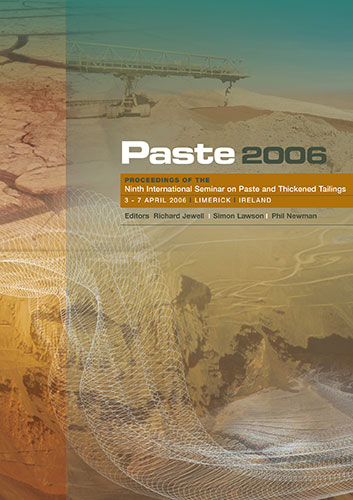Another Dimension to Slump

|
Authors: Vietti, AJ; Dunn, F |
DOI https://doi.org/10.36487/ACG_repo/663_3
Cite As:
Vietti, AJ & Dunn, F 2006, 'Another Dimension to Slump', in R Jewell, S Lawson & P Newman (eds), Paste 2006: Proceedings of the Ninth International Seminar on Paste and Thickened Tailings, Australian Centre for Geomechanics, Perth, pp. 25-36, https://doi.org/10.36487/ACG_repo/663_3
Abstract:
Estimating the rheological properties of a paste using convenient methods such as the slump technique are common practice within the industry. However, the universality of comparing slump heights to estimate the flow properties for different paste products has been questioned (Clayton et al., 2003; Paterson, 2002). The dispute relates to the fact that two paste products may in fact exhibit similar slump heights, but may not share the same shear yield strength since their densities may be different. This discrepancy is catered for by the method of Pashias et al. (1996) in which the shear yield stress can be conveniently calculated from the slurry density and the slump height. However, certain paste rheological behaviours are observed which appear puzzling and which cannot be explained on the basis of particle size and slurry density alone. The chemical conditions of pastes (particularly those containing clay minerals) have profound effects on the colloidal interactions of the suspended solids and hence on the rheological behaviour of pastes (Vietti, 2004; Dunn, 2005). This paper demonstrates that different slump heights may be observed for a kimberlite paste containing smectite at one material density, but varying paste chemical conditions.
References:
Brindley, G.W. and Brown, G. (1980) Crystal structure of clay minerals and their X-ray identification, Brindley, G.W. and Brown, G.
(eds.), Mineralogical Society, London.
Clayton, S., Grice, T.G. and Boger, D.V. (2003) Analysis of the slump test for on-site yield stress measurement of mineral
suspensions, International Journal of Mineral Processing, Volume 70, pp. 3-21.
Dunn, F. (2005) A study of the relationship between various slurry material characteristics and the flow behaviour of co-disposed
kimberlite tailings upon deposition, MSc thesis, University of the Witwatersrand, Johannesburg.
Fourie, A.B. (2002) Materials characterisation, Paste and thickened tailings – a guide, Jewell, R.J., et al. (eds), Australian Centre for
Geomechanics, pp. 35-47.
Klein, C. (2002) Mineral Science (22nd edition), John Wiley & Sons, New York.
Pashias, D.V., Boger, N.P., Summers, K.J. and Glenister, D.J. (1996) A fifty cent rheometer for yield stress measurement, J.
Rheology, Vol. 40, No. 6, pp. 1179-1189.
Paterson, A. (2002) Is slump a valid measure of the rheological properties of high concentration paste slurries? Proceedings 15th
International Conference of Slurry Handling and Pipeline Transport, Banff, Canada.
Richards, L.A. (ed.) (1969) Diagnosis and improvement of saline and alkali soils, US Dept. Agriculture Handbook No. 60.
Yield stress vs % solids
0
100
200
300
400
500
600
700
800
50 55 60 65 70 75
% Solids
Yi
el
d
st
re
ss
(P
a)
pH 8.6 - Vane
pH 8.6 - Slump
pH 6.2 - Vane
pH 6.3 - Slump
pH 11.5 - Vane
pH 11.5 - Slump
Paste2006,Limerick,Ireland 35
rheology And thicKening
Svarovsky, L. (ed) (1981) Solid-liquid separation (2nd edition), Butterworths, London.
Tessier, D. (1990) Behaviour and microstructure of clay minerals. Soil colloids and their associations in aggregates, M. F. De Boodt
et al., (eds.), Plenum Press, New York, pp. 387 – 415.
Tuller, M. and Or, D. (2003) Hydraulic functions for swelling soils: Pore scale considerations, Journal of Hydrology, pp. 50 – 71.
Van Olphen, H. (1977) Clay colloid chemistry, John Wiley & Sons, New York.
Vietti, A.J. (2004) Know your chemistry – Suspension and compaction behaviour of paste, International Seminar on Paste and
Thickened Tailings, Paste 2004, 31 March – 2 April 2004, Cape Town, South Africa.
36 Paste2006,Limerick,Ireland
AnotherDimensiontoSlump A.J.Vietti,F.Dunn
© Copyright 2025, Australian Centre for Geomechanics (ACG), The University of Western Australia. All rights reserved.
View copyright/legal information
Please direct any queries or error reports to repository-acg@uwa.edu.au
View copyright/legal information
Please direct any queries or error reports to repository-acg@uwa.edu.au